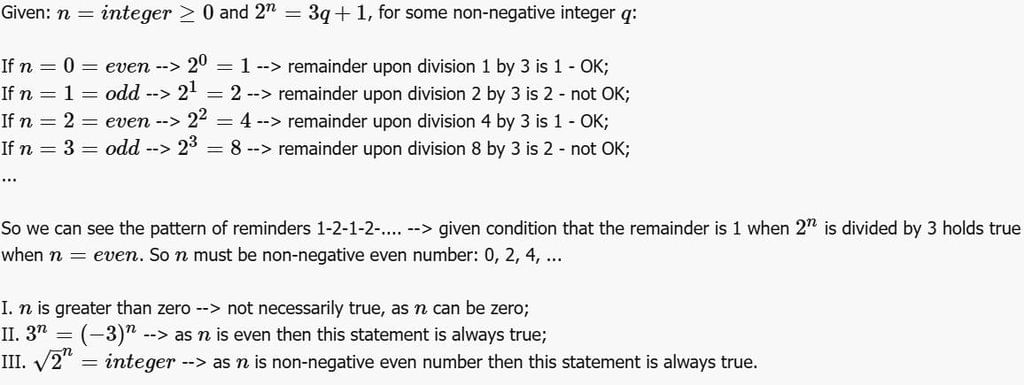Test: Remainders- 1 - GMAT MCQ
15 Questions MCQ Test Quantitative for GMAT - Test: Remainders- 1
When positive integer x is divided by 5, the remainder is 3; and when x is divided by 7, the remainder is 4. When positive integer y is divided by 5, the remainder is 3; and when y is divided by 7, the remainder is 4. If x > y, which of the following must be a factor of x - y?
If n is a positive integer, what is the remainder when 38n+3 + 2 is divided by 5?
| 1 Crore+ students have signed up on EduRev. Have you? Download the App |
What is the remainder when the positive integer n is divided by the positive integer k, where k > 1?
1) n = (k+1)3
2) k = 5
What is the remainder when the sum of the positive integers x and y is divided by 6?
1) When x is divided by 6, the remainder is 3.
2) When y is divided by 6, the remainder is 1.
When 20 is divided by the positive integer k, the remainder is k – 2. Which of the following is a possible value of k?
Seven different numbers are selected from the integers 1 to 100, and each number is divided by 7. What is the sum of the remainders?
1) The range of the seven remainders is 6. ?
2) The seven numbers selected are consecutive integers. ?
When 15n, where n is a positive integer, is divided by 6, the remainder is x. What is the value of x?
1) When n is divided by 2, the remainder is 0
2) When n is divided by 3, the remainder is 0
If n is a positive integer, what is the remainder when (7(4n+3))(6n) is divided by 10?
For a nonnegative integer n, if the remainder is 1 when 2n is divided by 3, then which of the following must be true?
I. n is greater than zero. ?
II. 3n = (-3)n ?
III. (√2)n is an integer.
If n is a positive integer and r is the remainder when (n – 1)(n + 1) is divided by 24, what is the value of r?
1) 2 is not a factor of n. ?
2) 3 is not a factor of n.
What is the remainder when the two-digit, positive integer x is divided by 3 ?
1) The sum of the digits of x is 5.?
2) The remainder when x is divided by 9 is 5.
What is the remainder when the positive integer x is divided by 8?
1) When x is divided by 12, the remainder is 5. ?
2) When x is divided by 18, the remainder is 11 ?
When positive integer x is divided by positive integer y, the remainder is 9. If x/y = 96.12, what is the value of y?
For all positive integers m and v, the expression m Θ v represents the remainder when m is divided by v. What is the value of ( (98 Θ 33) Θ 17 )− ( 98 Θ (33 Θ 17) ) ?
How many integers from 0 to 50, inclusive, have a remainder of 1 when divided by 3?
|
115 videos|106 docs|113 tests
|
|
115 videos|106 docs|113 tests
|


















